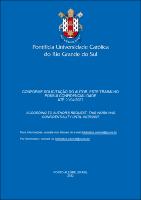| Share record |


|
Please use this identifier to cite or link to this item:
https://tede2.pucrs.br/tede2/handle/tede/10170| Document type: | Tese |
| Title: | Papel da hidrólise extracelular de ATP na imunossupressão, resistência à quimioterapia e invasividade dos gliomas |
| Author: | Scheffel, Thamiris Becker  |
| Advisor: | Morrone, Fernanda Bueno |
| Abstract (native): | Os gliomas são tumores cerebrais extremamente agressivos. A malignidade tumoral tem sido atribuída aos diversos mecanismos de resistência à terapia que compreendem a intensa capacidade imunomodulatória e a invasão do tecido subjacente. Sugere-se que purinas e pirimidinas possam atuar como moléculas sinalizadoras, influenciando tais características. A hidrólise de ATP pelas ectonucleosídeo trifosfato difosfoidrolases (ENTPDases) e a consequente formação de adenosina estão relacionadas à regulação positiva de vias de proliferação, migração, sobrevivência celular e de checkpoints imunológicos inibitórios como a via PD-1/PD-L1. Deste modo, a hipótese deste trabalho é que a inibição da atividade ATPásica resultaria na redução da imunossupressão, da resistência à quimioterapia e da invasividade tumoral, de forma direta ou indiretamente através da ação no microambiente tumoral. A atuação sinérgica da via da adenosina e do eixo PD-1/PD-L1 na manutenção da imunossupressão em gliomas foi descrita neste trabalho. É notório o envolvimento destas vias na progressão dos gliomas. Neste contexto, a inibição da formação de adenosina juntamente com o favorecimento de altas concentrações de ATP extracelular poderiam aumentar a carga inflamatória antitumoral no microambiente tumoral e minimizar os mecanismos tumorais de resistência à terapia. O uso do inibidor de E-NTPDases polioxometalato-1 (POM-1) mostrou estar relacionado com a potencialização do efeito da temozolomida, através da redução da viabilidade celular e indução de apoptose em células de glioblastoma (GBM). Além disso, a análise do potencial invasivo-migratório das células de GBM foi avaliado em modelo de cultura tridimensional através do método migratory fitness, desenvolvido ao longo deste trabalho. A inibição da hidrólise extracelular de ATP favoreceu a ocorrência de um fenótipo celular menos invasivo, reduzindo a massa de células migratórias. Com base nos achados in vitro, o efeito do POM-1 foi avaliado em um estudo piloto de GBM em modelo murino que envolveu a administração intranasal do inibidor e demonstrou uma forte tendência ao aumento da inflamação no local do tumor e redução da infiltração de linfócitos Tregulatórios, que caracteriza redução da imunossupressão. De modo geral, este trabalho demonstra estratégias de modulação do microambiente tumoral que enfraquecem mecanismos de resistência à temozolomida e minimizam a invasividade de tumores extremamente malignos. |
| Abstract (english): | Gliomas are extremely aggressive. Tumor malignancy has been attributed to several mechanisms of resistance to therapy that include the intense immunomodulatory capacity and the invasion of the underlying tissue. It is suggested that purines and pyrimidines may act as signaling molecules, influencing such characteristics. ATP hydrolysis by ectonucleoside triphosphate diphosphohydrolases (E-NTPDases) and the consequent formation of adenosine are related to the positive regulation of proliferation, migration, cell survival and inhibitory immunological checkpoints such as the PD-1/PD-L1 pathway. Thus, the hypothesis of this study is that the inhibition of ATPase activity would result in the reduction of immunosuppression, resistance to chemotherapy and tumor invasiveness, directly or indirectly through action on the tumor microenvironment. The synergistic action of the adenosine pathway and the PD-1/PD-L1 axis maintaining immunosuppression in gliomas was described in this study. The involvement of these pathways in the progression of gliomas is well known. In this context, the inhibition of adenosine formation together with the favoring of high concentrations of extracellular ATP could increase the antitumor landscape in the tumor microenvironment and minimize the tumor mechanisms of resistance to therapy. The use of the E-NTPDase inhibitor polyoxometalate-1 (POM-1) was shown to be related to the potentiation of the effect of temozolomide, through the reduction of cell viability and induction of apoptosis in glioblastoma cells (GBM). Furthermore, the analysis of the invasive-migratory potential of GBM cells was evaluated in a 3D culture model using the migratory fitness method, developed throughout this work. Inhibition of extracellular ATP hydrolysis favored the occurrence of a less invasive cellular phenotype, reducing the mass of migrating cells. Based on in vitro findings, the effect of POM-1 was evaluated in a pilot study of GBM murine model that involved intranasal administration of the inhibitor and demonstrated a strong tendency to increase inflammation at the tumor site and reduce lymphocyte infiltration of regulatory T cells, which characterizes reduced immunosuppression. Overall, this work demonstrates tumor microenvironment modulation strategies that weaken temozolomide resistance mechanisms and minimize the invasiveness of extremely malignant tumors. |
| Keywords: | Gliomas Imunossupressão Temozolomida Invasividade Tumoral |
| CNPQ Knowledge Areas: | CIENCIAS BIOLOGICAS::BIOLOGIA GERAL |
| Language: | por |
| Country: | Brasil |
| Publisher: | Pontifícia Universidade Católica do Rio Grande do Sul |
| Institution Acronym: | PUCRS |
| Department: | Escola de Ciências Saúde e da Vida |
| Program: | Programa de Pós-Graduação em Biologia Celular e Molecular |
| Access type: | Acesso Aberto |
| Fulltext access restriction: | Trabalho será publicado como artigo ou livro |
| Time to release fulltext: | 60 meses |
| Date to release fulltext: | 29/04/2027 |
| URI: | https://tede2.pucrs.br/tede2/handle/tede/10170 |
| Issue Date: | 18-Apr-2022 |
| Appears in Collections: | Programa de Pós-Graduação em Biologia Celular e Molecular |
Files in This Item:
| File | Description | Size | Format | |
|---|---|---|---|---|
| TES_THAMIRIS_BECKER_SCHEFFEL_CONFIDENCIAL.pdf | THAMIRIS_BECKER_SCHEFFEL_TES | 225.88 kB | Adobe PDF |  Download/Open Preview |
Items in DSpace are protected by copyright, with all rights reserved, unless otherwise indicated.




